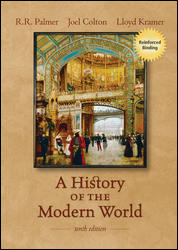 
History of the Modern World, 10th Edition (Palmer)Chapter 9:
The French RevolutionLearning ObjectivesChapter 9 teaches students about:
How the old regime was replaced by modern society during the French Revolution. |
 |  |  |
The Three Estates of the old regime, and the thwarted ambitions of both peasants and urban dwellers in prerevolutionary France. |
 |  |  |
The tensions between the Third Estate, the nobility, and the king. |
 |  |  |
The founding and initial reforms of the National Assembly or Constituent Assembly, which favored the middle classes. |
 |  |  |
The formation of a revolutionary culture and the role of popular participation in the revolution. |
 |  |  |
The gradual involvement of other European powers in a war with France and the impact of war on the revolution. |
 |  |  |
The influence of various factions within the revolution, such as the Girondins, the sans-culottes, and others. |
 |  |  |
The National Convention, the execution of the king, and the commencement of the Terror. |
 |  |  |
The Committee on Public Safety, which operated as a joint dictatorship or war cabinet. |
 |  |  |
The relations of the revolutionary governments with the church and the process of dechristianization. |
 |  |  |
The first French Republic, the Directory, and the narrowness of its social base. |
 |  |  |
Napoleon Bonaparte’s spectacular rise to power. |
 |  |  |
Napoleon’s enlightened despotism and the restoration of order and peace at home and abroad. |
 |  |  |
The emergence of a modern state under Napoleon, which combined aspects of the revolution and the old regime. |
 |  |
|





